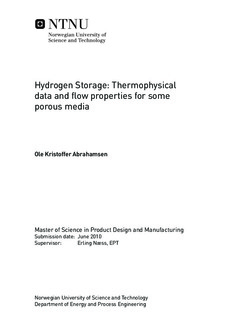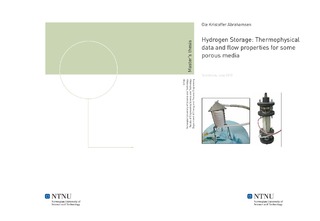| dc.contributor.advisor | Næss, Erling | nb_NO |
| dc.contributor.author | Abrahamsen, Ole Kristoffer | nb_NO |
| dc.date.accessioned | 2014-12-19T11:45:32Z | |
| dc.date.available | 2014-12-19T11:45:32Z | |
| dc.date.created | 2010-09-21 | nb_NO |
| dc.date.issued | 2010 | nb_NO |
| dc.identifier | 352475 | nb_NO |
| dc.identifier | ntnudaim:5600 | nb_NO |
| dc.identifier.uri | http://hdl.handle.net/11250/234022 | |
| dc.description.abstract | Two rigs have been developed and built to measure thermal conductivity and permeability for porous materials. The intention of the rigs is to investigate the properties of some hydrogen adsorption materials. The materials are only available in small volumes which have been taken into consideration under the development. Fourier s law of heat conduction has been used as a basis for the development of the thermal conductivity rig. A cylindrical geometry with centered heater was chosen to ensure that all heat must be transported through the specimen. The temperature and heat distribution have been evaluated numerically to find the required insulation on top and bottom. Based on the chosen insulation, the rig is able to measure the conductivity for specimens with minimum conductivity of 0.1 W/mK. To make the rig capable of measurements at different temperatures, a side wall cooling system has been developed where fluid is transported on the outer side of the rig. Depending on the coolant fluid, the rig is capable of measurements within a wide temperature range. Liquid nitrogen and tap water have been used in the measurements where the lowest measurement was performed at -137degC. The uncertainties have been determined where the positioning of the thermocouples have been shown to be most affecting due to the small dimensions of the rig. The results have an uncertainty of +-10%. The permeability rig have been developed using the principles of Darcy s law. To estimate the magnitude of the flow rate and pressure loss for a given material, a set of empirical equations has been used. Based on the estimations it turned out that great variations in pressure loss can be expected depending on the pore size diameter of the material. They also stated the validation of Darcy s law which is for slow viscous flow only. The uncertainties in the equipment have been estimated and indicated that results can be obtained with an uncertainty less than 10%. The measurements pointed out that the geometry of the rig should be modified as the pressure loss turned out to be too small. Due to delays, the adsorption materials were not available when the rigs were ready for measurements; therefore, other materials were chosen to test the rigs. The permeability results has been compared to the estimation based on the pore size diameter of the materials. For the conductivity rig, the results were harder to verify since the properties such as porosity and conductivity of the solid phase not were known. | nb_NO |
| dc.language | eng | nb_NO |
| dc.publisher | Institutt for energi- og prosessteknikk | nb_NO |
| dc.subject | ntnudaim | no_NO |
| dc.subject | MTPROD produktutvikling og produksjon | no_NO |
| dc.subject | Energi- | no_NO |
| dc.subject | prosess- og strømningsteknikk | no_NO |
| dc.title | Hydrogen Storage: Thermophysical data and flow properties for some porous media | nb_NO |
| dc.type | Master thesis | nb_NO |
| dc.source.pagenumber | 127 | nb_NO |
| dc.contributor.department | Norges teknisk-naturvitenskapelige universitet, Fakultet for ingeniørvitenskap og teknologi, Institutt for energi- og prosessteknikk | nb_NO |

